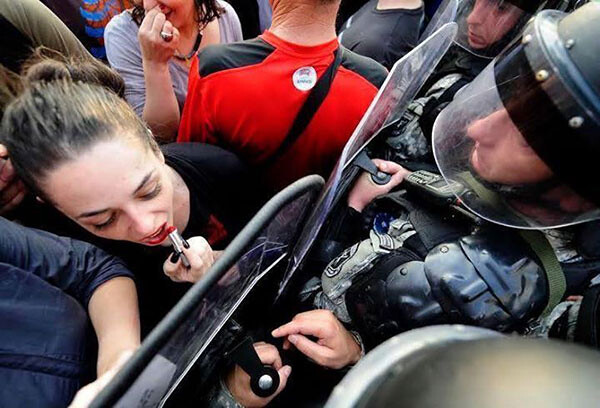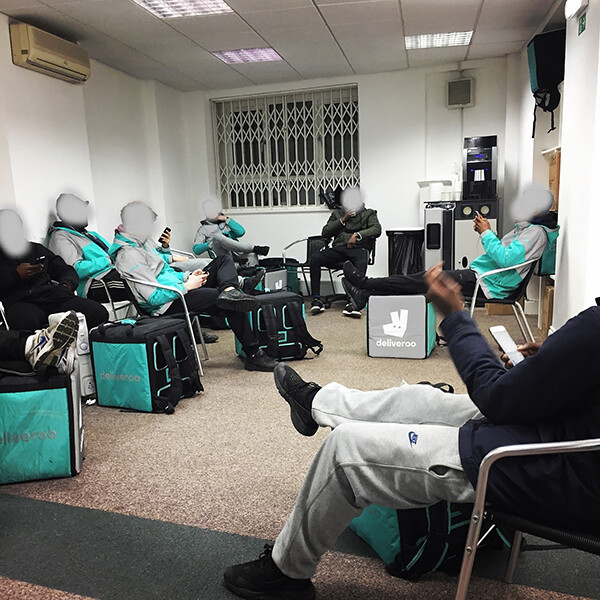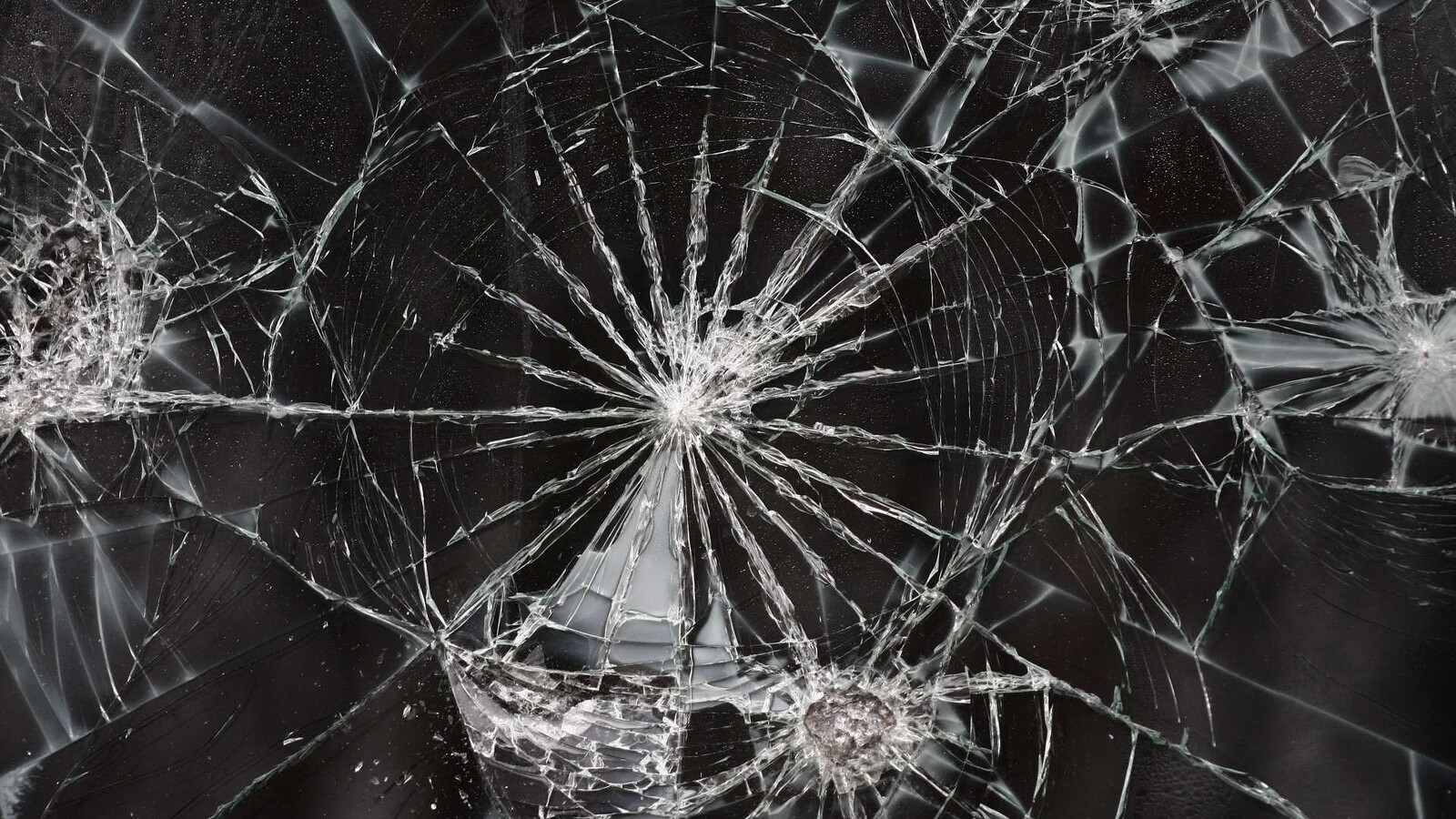Imagine a big roll call. Names of nations, creeds, and genders are called out. Everyone is supposed to join their kin. Several hours later the crowd is all divided up into groups and subgroups, all neatly arranged on a large grid. There is just one person left. And this person says, “Sorry guys, I’m with the universe. Where do I go?”
The universe? It does not figure on the grid. Today, the most important question is not what belongs to whom but who belongs to what—as in what kind of group. Sameness trumps equality. Similarity beats solidarity. Reality is a battlefield. If the era of the October Revolution was epitomized by Malevich’s Black Square, the current one is ruled by Reality TV.
The struggle for reality characterizes today’s reactionary turn. Populisms try to define the “real” people and mark anyone else as “unreal”—thus anticipating their erasure from reality altogether. In the populist view, reality is defined as brute inevitability, by ranking, ratings, and elimination, by literally showing people their place.
But is identity a natural given, or is it also data? How about iPads, iPhones, ego brands? How about facial recognition? How about chips and keys and passwords? IPv6? Blockchain reputation systems? Technologies boost identities and make them happen. Identities in turn obscure technologies.


How to search for like-minded people IRL.
Identity today is not what it was even twenty years ago. It pops up as autofill suggestions in drop-down menus. It is intensified by punitive quantification, by viral lynch mobs, material deprivation, browser memory. Traditional identities ran on race, class, gender, plain loyalty, money, or memory. Contemporary ones add proprietary operating systems to this mix. How is your newsfeed organized? Your loyalty scheme? How does your credit score soar or shrink? Who owns your interactions or opinions? To know yourself and kin today, forget about a shaman or a shrink. You might need a Ukrainian hacker.1
The roll call does not call people back to their origins or their true self. Rather, it drags them into an automated future. Identity appears anew when social relations are captured, privatized, and reorganized. Reality—the brute-force kind—is deeply algorithmic.
So, who does one belong to? Belonging is both about property and about social relations. Who owns social relations then?


The worker’s body dances around the chair in this exoskeleton design titled Chairless Chair by Sapetti.
Table Dance
Marx’s introduction to Capital features a cameo by a dancing table. The table, of course, is a commodity. It seems to move on its own, but this is an illusion. Its dance is animated by the interests and actions of the people around it, beneath it, behind it. Like a turning table, the commodity is animated by off-screen forces.2
Today the contrary applies. The table has transformed into a set of platforms, which turn people against one another, making their movements appear autonomous when they aren’t. Their “dance” is animated by the interests and actions of underlying platforms—or rather than “animated”: automated. To put it more succinctly: Digital platforms are not expressions of social relations among people. Social relations among people are automated by platforms.3
As technology churns out ever more universal aspirations—from cyberspace to the internet of everything to Ether—it works by segregation in high definition, fueled by organized depression, failing bureaucracy, magic sauce. Rancor is monetized. Rage fuels the machine. Hate pays off handsomely. Intensity is mined as industry. Digital chaos is a ladder, not a pit.4 It divides people into peoples: defined as customers-slash-clans, linked by ancestry or algorithm, DNA or DNS, being @real yet unequal.
How does technological identity management relate to right-wing troll-powered isolationism? Do today’s reactionary identity politics anticipate systems of pervasive technological address?5 Do protocols of future quantification already cast their shadow over contemporary reality? How come quantitative realism—a roll call of a different sort—aligns so well with nativist politics? 6
The algorithmic provocation of identity has engulfed art as well. Mega art shows gush about ritual and nonalienation while deploying clay and cymbals. But disavowing digital reality means falling under the spell of its prefabricated structures. Shows splinter into aggregated filter bubbles. Biography replaces context. Hashtag curating (#genocide) tosses ethnographic samples into 3-D space. As Marshall McLuhan flatly states: “A moral point of view too often serves as a substitute for understanding in technological matters.”7


Affectiva’s facial recongnition software promises to automate affective labor with ‟emotional recognition.” It does so by interpreting facial expressions into easily readable emojis for AI to customize responses to clients’ different emotions.
Black Square as Document
That’s where we circle back to the October Revolution. If contemporary realisms are algorithmic, how about abstraction today? Or—what is the equivalent of The Black Square in the age of Reality TV?
Let’s look at The Black Square again then, from the perspective of today. What if Malevich’s Black Square was a documentary image? What if it actually showed the universe in the sense of outer space?8 This perspective on the universe would not be a claim on totality or monopoly, but a claim to reality itself, in its less-than-perfect, even fragmented form. The Black Square might show the universe in all its imperfection. From this point of view, the universe is not another territory to be ingested, not a frontier to be exploited and mined, not a maximalist scam or a kingdom come seen from above. It is a humble portrait in very low resolution—perhaps just one pixel, give or take.
This documentary approach to the universe is different from traditional philosophical or religious ideas of universalism, which claimed to be for all, but usually worked only for a few.9 From this perspective, universality is not the biggest common denominator. It is not a generalization of everything. There is no general ordering position or definition. This kind of universality is not strategic, but strange. Why? Seen scientifically, the universe is a strange and vastly unknown entity with many different interlocking dimensions. It potentially consists of strange matter, wormholes, and complex n-dimensional non-euclidian spaces, in which terms like “grid,” “immanence,” “territory,” and “exclusion” dramatically change or even lose their meaning. 10
Strange universalism is something both more and less than general, both below and beyond the realm of forms. 11 Under current conditions, it cannot fully grasp let alone own itself. It does not refer to a “whole” or a totality, but to something smaller than its parts,12 each one potentially exceeding it in detail and complexity. Anyone younger than nine years old knows that a couple of universes easily fit into a pocket.


Pucker up! A protester in Macedonia weaponizes lipstick. Photo: Biljana Ginova & Jasmina Golubovska.
This is the Universe
Seen from this perspective, The Black Square cancels the blank horror of the white canvas as a seemingly neutral and objective ground. It resolutely replaces its bleak tabula rasa with a fragment of the cosmos. The Black Square is neither ground nor figure, neither background nor projection screen. It is a base without a superstructure, full of hidden undercurrents shining forth through its cracks.13 Seen as just space, The Black Square is both fully documentary and completely encrypted, both abstract and indexical. It shows absence as link.14


Deliveroo servers’ downtime, January 2017. This image was originally used to illustrate the text ‟Far From Seamless: a Workers’ Inquiry at Deliverooby” by authors Facility Waters and Jamie Woodcock, see →.
The Black Square is not the same as it was one hundred years ago, even materially.15 It’s meanings have been amplified through its own aging and history, even if Malevich most definitely didn’t intend any of it. What if one chose now to see the network of its cracked and decaying paint as anticipating the recent detection of filaments of so-called dark matter—a web connecting distant galaxies?16 What other meanings will the painting lend itself to in another hundred years?
But all this avoids the question: What is The Black Square’s equivalent in the age of Reality TV?
The answer is very simple: today, The Black Square could be anywhere. It is potentially ubiquitous. It has pervaded reality without anyone noticing. It has gone viral like a 3-D meme. Today, The Black Square is any TV or phone screen that is switched off. The Black Square has become The Black Screen.
Whatever is shown on screens today is mostly numbers posing as people. In contrast, The Black Screen does not present media realisms, but rather the reality of mediation. It doesn’t show Reality TV, but demonstrates that proliferating screens are real. The black surface of the screen could be the exterior of the black-box algorithms operating behind it. In this case, The Black Screen becomes a documentary image of real-existing technology and its nontransparent mode of operation. The Black Square’s white frame is replaced by a slim metal frame bearing the name of a corporation. This is the new normal, the standard blank page or canvas.
But one could also turn the table once again. The Black Screen thus becomes a platform under which people move undetected and undeterred. It is not like Uber, but like unter, not used from above but from below. In a grid made of these kinds of Black Screens, every single square would point to the universe, and nothing but the universe. This grid might be the negative version of corporate and populist identity management, which classifies, ranks, and rates. If platforms turn tables against people, one could also turn the platforms: in this case, upside down.
So close your eyes a little, squint a bit: through the dark screen, the universe looks back at you.
In this issue:
Boris Buden and Darko Suvin—Only Intelligent Planning Can Save Us
“Oblivion” is too normal a term for what was and still is happening in “post-communism,” in that famous “transition” to primordial, predatory, or Raubcapitalism without a human face in the whole of the ex-Soviet bloc plus Yugoslavia. The counterrevolutions may have in some cases (not in most of ex-Yugoslavia) been velvet ones, but for the most part they always had an iron fist consisting of military violence and financial reengineering toward scarcity and dependence on private funding: in brief, a violence dependent on tanks and banks.
Hito Steyerl and Rojava Film Commune—The Color of Women: An Interview with YPJ Commanders Dilovan Kobani, Nirvana, Ruken, and Zerin
As revolutionaries, as an army of women, of course our desire is equality, permanent equality. Not only for Kurds and their land, not only for the Middle East, but for the whole world. Because the pride of humanity is one, and in our times, it’s trampled under foot. No one should be ruling, no one should be oppressed. We would like the whole world to know about our philosophy and politics.
Jodi Dean—Four Theses on the Comrade
When people say “comrade,” they change the world. Gorky’s examples include the prostitute who feels a hand on her shoulder and then weeps with joy as she turns around and hears the word “comrade.” With this word, she is interpellated not as a self-commodifying object to be enjoyed by another, but as an equal in common struggle against the very conditions requiring commodification. Additional examples are a beggar, a coachmen, and young combatants—for all, “comrade” shines like a star that guides them to the future.
Önder Çakar, Rojava Film Commune, and Hito Steyerl—“I don’t have time!”
The second explosion that happened when we were in the stairway was caused by a Daesh suicide bomber with an explosive vest who was following the truck. He was crawling in the dark. There was a young female fighter, seventeen or eighteen years old, on the second floor of a building nearby. She had no bullets left because she had used all her ammunition to stop the truck. She saw him crawling. If he managed to get through, many people would die. She threw herself on him to reduce the impact. And she died with him. We are alive because of that girl. I didn’t learn her name, so I don’t know who she is. Maybe this is just a metaphor, but I personally witnessed the collapse and resistance of Kobane. Since then, whenever I go to Kobane, for filming or for activities related to the film commune, I feel a great pride. We were there and we defended the place with our lives, and it didn’t fall. Whenever I go there, it feels like I am going to my mother’s home.
Boris Groys—Towards a New Universalism
The politicization of art mostly happens as a reaction against the aestheticization of politics practiced by political power. That was the case in the 1930s and it is the case now. For some time after the end of the Cold War, the political process seemed to be reduced to the tedious, boring work of administration. This bureaucratic work did not need art—and art was not especially interested in it. However, today politics has become a spectacle again. On its stage we see the individuals who seem to have an artistic charisma of a certain kind. These individuals are celebrated but also passionately opposed. It is obvious that in this situation art cannot remain neutral because politics has entered its own territory. It is also obvious that the contemporary art scene almost unanimously rejects the new populist movements and their leaders. This rejection has political reasons—but it has even deeper aesthetic reasons.
Yuk Hui—Cosmotechnics as Cosmopolitics
Dao is not a thing. It is not a concept. It is not the différance. In the Cixi of YiZhuan, Dao is simply said to be “above forms,” while Qi is what is “below forms.” We should notice here that xin er shang xue (the study of what is above forms) is the word used to translate “metaphysics” (one of the equivalences that must be undone). Qi is something that takes space, as we can see from the character and also read in an etymological dictionary—it has four mouths or containers and in the middle there is a dog guarding the utensils. There are multiple meanings of Qi in different doctrines; for example, in classic Confucianism there is Li Qi, in which Qi is crucial for Li (a rite), which is not merely a ceremony but rather a search for unification between the heavens and the human. For our purposes, it will suffice to simply say that Dao belongs to the noumenon according to the Kantian distinction, while Qi belongs to the phenomenon. But it is possible to infinitize Qi so as to infinitize the self and enter into the noumenon—this is the question of art.
Stephen Squibb—Parahistories of Self-Instituting Sunlight
We can imagine a number of different planets confronting our problem in their own ways. Maybe some just solve climate change the way we solved polio. Maybe the sixth planet in Alpha Centauri just got solar power correct relatively quickly and the whole problem was avoided. But maybe this same planet struggled for centuries to construct an internal combustion engine. Maybe they never discovered the novel or invented their version of basketball. I wonder: of all the things we cherish about our semi-intelligent self-instituting existence together, which are truly rare in the universe and which are hopelessly common?
Suely Rolnik—The Spheres of Insurrection: Suggestions for Combating the Pimping Life
The dreary fate of left resistance and the repeated frustration it provokes in us, added to the confusion and the fear mobilized by the current state of things, is what leads us today to become aware of the absolute limitations of the macropolitical horizon on the leftist territory. Here and there erupt insurrections with new strategies in response to the violence against life, in all its nuances, for which the pair right/left is no longer a sufficient operator to delineate the players in the game, nevermind hit the target. Aren’t we surprised by the presence of micropolitical insurrection in the new resistance movements bursting out everywhere—mainly in the younger generations, but especially in the suburbs and among blacks, indigenous peoples, women, and LGBT people? Isn’t this precisely what fascinates us in these movements, despite the difficulty of deciphering and naming it? Does such vital insurrection have the power to prevent us from succumbing to the melancholic and fatalistic paralysis that throws us into the bleak landscape surrounding us?
Stefano Harney and Fred Moten—Base Faith
There’s a movement of the earth against the world. It’s not the movement. It’s not even a movement. It’s more like what Tonika calls a procession, a holy river come down procession, a procession in black, draped in white. The earth’s procession sways with us. It moves by way of a chant. It steps in the way of the base, in the way of the dancing tao. It bows to the sisters of the good foot, carrying flowers from Caliban’s tenderless gardens. The earth is on the move. You can’t join from the outside. You come up from under, and you fall back into its surf. This is the base without foundation, its dusty, watery disorchestration on the march, bent, on the run. Down where it’s greeny, where it’s salty, the earth moves against the world under the undercover of blackness, its postcognitive, incognitive worker’s inquest and last-played radio.
Sorry Ukrainian hackers! In this case you are performing a social service for people, such as US farmers who are not allowed to repair their own tractors because the software remains the property of a corporation.
Table-turning—that parlor trick whereby spiritualist performers made ghosts dance for a select few—is Marx’s metaphor for the commodity. [See also David Riff, “Was Marx a Dancer?,” e-flux journal (November 2015) →
Of course, this is a complete oversimplification. People have agency. But what exactly moves people today, and how it makes them move, is difficult to assess in a world where platforms manipulate social affect through fake rage, perception management, and permanent disruption. By “platforms” I mean primarily social media, but this could also come to mean any kind of decentralized autonomous organization (DAO), smart contract, or coin scheme on a blockchain or high-definition digital-address system. A great example is described in Facility Waters and Jamie Woodcock’s text‟Far From Seamless: a Workers’ Inquiry at Deliveroo” See →
Littlefinger meets Aleksandr Dugin.
Of course they do. They also recall earlier systems of this kind, taking us back to the time of radio-instigated ethnic cleansing, printing-press disseminated anti-Semitism, and IBM/Hollerith-enabled deportation lists.
See Suely Rolniks wonderful analysis in this issue. →
Marshall McLuhan, Understanding Media: The Extensions of Man (New York: McGraw-Hill, 1964), 245.
This was an argument advanced by the show “Art Without Death: Russian Cosmism,” curated by Anton Vidokle and Boris Groys at HKW earlier this year. See also Groys’s text in this issue. There is no indication that Malevich intended The Black Square to show outer space, except for abundant references to the cosmos throughout his work. Yet, reading a seeming abstraction as a portrait is encouraged by the red square of his Painterly Realism of a Peasant Woman in Two Dimensions. I´ve made this point earlier in a text called The Empire of Senses (online at eipcp) where I also discuss Alain Badiou’s reading of White on White in Die Passion des Realen, Alain Badiou, Das Jahrhundert, Zürich: Diaphanes, 2006, S 70ff. This point has also been made by Trevor Paglen in unpublished presentations about his project Orbital Reflector.
This point requires a lengthy explanation, which I will need to provide in a longer version of this piece to be written in the future. But the point is partly addressed in Boris Buden conversation with Darko Suvin in this issue.
And potentially sunlight organizes in a semi-intelligent way, see Stephen Squibb’s text in this issue. →
See Yuk Hui in this issue. →
Thanks to Tim Morton for making this clear to me and for pointing me to “On Black Negativity, Or the Affirmation of Nothing: Jared Sexton, interviewed by Daniel Colucciello Barber,” see → .
See Stefano Harney and Fred Moten’s piece in this issue.
See also →
I am referring to the claim by Russian’s State Tretyakov Gallery, where The Black Square is housed, that the white border of the painting bears the traces of an erased racist graffito. There are different opinions as to who scrawled it, but regardless, in my view this is what the white frame in this composition is all about. See Aleksandra Shatskikh, “Inscribed Vandalism: The Black Square at One Hundred,” e-flux journal 85 (October 2017) →.
See “Researchers capture first ‘image’ of a dark matter web that connects galaxies,” phys.org, April 12, 2017 →.
Subject
Author’s note: This is a draft for a future text and thus it does not yet contain the full credits and references. For the moment let me refer to Wendy Chun, Boris Groys, Helen Kaplinsky, Trevor Paglen, Stephen Squibb, David Riff, Fred Moten, and Stefano Harney—this list is far from complete.

